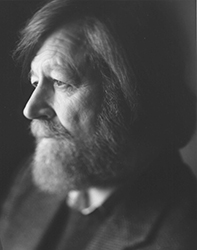 The last of my seasonal favourites uses one of the oldest texts heard at Christmas. ‘O magnum mysterium’ has been used as a chant on Christmas morning for well over a millennium, and may date from as far back as the 6th century. As so many Christmas-related texts do, it explores the immense contrast of sacred and secular, here between the great mystery of God born as a human being and the fact that He lies in a manger, watched around by animals—the profound and the prosaic, cheek by jowl. Throughout the last 500 years, many composers have been drawn to this text—the settings by Palestrina, Victoria and Poulenc are among the most well-known—but the setting by Morten Lauridsen, composed in 1994, has become not only the most celebrated in recent times, but also one of the most-performed contemporary Christmas pieces of the last two decades. One doesn’t need to listen to much of Lauridsen’s music to realise that he has a decidedly single-minded approach to composition. Lauridsen has, it seems, little time or interest in the drama and dissonance of life, opting instead for untroubled subject matter and an indefatigably tonal palette. Heard in large quantities, i find Lauridsen’s music to be both stifling and disingenuous; but taken in small doses, as in O magnum mysterium, there’s much that rings true, much to celebrate.
The last of my seasonal favourites uses one of the oldest texts heard at Christmas. ‘O magnum mysterium’ has been used as a chant on Christmas morning for well over a millennium, and may date from as far back as the 6th century. As so many Christmas-related texts do, it explores the immense contrast of sacred and secular, here between the great mystery of God born as a human being and the fact that He lies in a manger, watched around by animals—the profound and the prosaic, cheek by jowl. Throughout the last 500 years, many composers have been drawn to this text—the settings by Palestrina, Victoria and Poulenc are among the most well-known—but the setting by Morten Lauridsen, composed in 1994, has become not only the most celebrated in recent times, but also one of the most-performed contemporary Christmas pieces of the last two decades. One doesn’t need to listen to much of Lauridsen’s music to realise that he has a decidedly single-minded approach to composition. Lauridsen has, it seems, little time or interest in the drama and dissonance of life, opting instead for untroubled subject matter and an indefatigably tonal palette. Heard in large quantities, i find Lauridsen’s music to be both stifling and disingenuous; but taken in small doses, as in O magnum mysterium, there’s much that rings true, much to celebrate.
Despite the obvious differences, the composer who comes most readily to mind when listening to this piece is Maurice Duruflé. Like Duruflé, Lauridsen is deeply interested in chant, but instead of taking existing chants and harmonising them (as Duruflé did, most famously in his Requiem), Lauridsen’s O magnum mysterium is, fundamentally, a piece of contemporary plainchant. Its melody comprises the very same kind of short and long durations one finds in that music, and its contour matches closely the emotional undulations of the text, sounding both natural and comfortable. Furthermore, the element of repetition—so prevalent in chant—is of singular importance here too; Lauridsen’s main melody occurs no fewer than three times (the overall structure is AABA), ensuring it’s well-retained in the memory. ‘Tonality’, as used in contemporary music, needs to be defined afresh for each composer who employs it, and for Lauridsen it consists of extremely simple triadic relationships that are enriched through additional diatonic notes. The result is a lush, humid brand of tonality that is undeniably inviting, but as i said before, becomes both dull and rather cloying when heard for long periods. In this context, it wins unconditionally, becoming one of the most ethereal paeans to the Nativity ever composed.
A dry acoustic will absolutely massacre this piece, as its chant-like rhythms will become dessicated and dead; hence why pretty much every recording of it (and by now there must be easily over a hundred), has been made in large, resonant spaces. The best i’ve heard—and it’s the best by a very large margin—is by the choir of Canterbury Cathedral on their 1998 album A Canterbury Christmas. Directed by David Flood, the choir achieves a simultaneous lightness of touch and richness of texture that is breathtaking; recorded in the cavernous space of Canterbury Cathedral gives Lauridsen’s music the room it needs to become a vast, unbroken line. Of course, the dense diatonic clusters depend on the lower parts, but it’s the trebles who are most outstanding, floating through the material and positively soaring at its high points. It’s a sumptuous, spine-tingling, utterly transparent performance of a real Christmas masterpiece.
